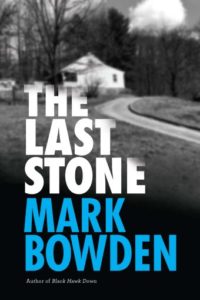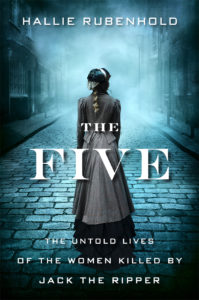These are boom days for writers and readers looking for thoughtful, hard-hitting stories about real-life crime. Whether you’re in the mood for a high-octane page-turner, an investigation, or a penetrating memoir, chances are there’s a book (and many a podcast or docu-series) out there for you. Every month, we round up the best new crime non-fiction with recommendations from CrimeReads staff. Here are the selections for April:
Mark Bowden, The Last Stone (Atlantic Monthly)
Bowden’s epic accounts of military operations—Black Hawk Down, Hue ‘68, and Killing Pablo, among others—have established him as one of the world’s most respected and widely read nonfiction authors, but before all that he was a cub reporter working in Baltimore when two girls, aged 10 and 12, disappeared from a shopping mall outside Washington D.C. The case was national news but went unsolved for decades; in 2013, a detective working on a cold case unit reignited the investigation with new discoveries, and a new theory that pointed to a man incarcerated on molestation charges. Bowden has now returned to the gripping, tragic story, hoping to provide a kind of ending. He charts the case’s progress with his usual skill and insight, saving a special intensity for his portraits of the interrogation of the suspect and his family. The Last Stone is an important addition to the recent revival of investigative nonfiction crime books.
JoeAnn Hart, Stamford ‘76: A True Story of Murder, Corruption, Race and Feminism in the 1970s (UOI Press)
In this moving memoir, JoeAnn Hart investigates the long-unsolved murder of a friend, and looks at how the crime intertwined with the vast social changes of the time. In 1976, 24-year-old Margo Olsen was found murdered, and the crime was pinned on her African-American boyfriend, Howie Carter, who was killed by police a few weeks later. JoeAnn Hart, who at the time was dating Howie’s best friend, looks at what the case reveals about the intersection of gender, race, class, and politics, and carefully interrogates her own role in the story.
Matthew McGough, The Lazarus Files: A Cold Case Investigation (Henry Holt)
In 1986, a young woman named Sherri Rasmussen was killed in her Los Angeles home, sparking an investigation that proved to be one of the era’s most closely watched and hotly debated. Police worked under the theory she was killed by a home invader after a desperate struggle. The trail soon went cold until, in the new era of DNA evidence and cold case units, detectives tested the bite marks on Rasmussen’s arm for DNA evidence and suddenly had a new suspect: a longtime LAPD detective, Stephanie Lazarus. This is the intricate, explosive case Matthew McGough chronicles in his new book, which is a learned, engaging study in how homicide investigations work, how the code of silence functions, and also provides the intimate texture of the three lives at the center of the story and how they intersected in one horrible moment. McGough is an experienced journalist who knows his subject inside and out and has a knack for human drama.
Hallie Rubenhold, The Five: The Untold Lives of the Women Killed by Jack the Ripper (HMH)
While most of us are familiar with the lurid details of the Ripper’s crimes, I and (I assume) many others are guilty of never having questioned the narrative of the victims themselves, essentially preserved in its Victorian form, and still framed based on the prevailing moral attitudes of the time. In Hallie Rubenhold’s masterful new social history of the lives of Jack the Ripper’s victims, we’re immersed in the harsh lives of late-19th-century Whitechapel and its residents’ struggle for survival in the face of a government that had spent the previous half-century criminalizing the state of being impoverished. We’re also treated to a skillful dissection of assumptions when it comes to who the Ripper’s victims truly were (i.e., homeless and impoverished women engaged in a variety of professions in order to carve out what little agency they could), as opposed to who those telling the story at the time wished them to be (i.e., prostitutes).

Dan Bilefsky, The Last Job: The “Bad Grandpas” and the Hatton Garden Heist (W.W. Norton)
The Last Job is as rollicking, intricate, and eye-opening a crime story as you’re likely to come across this season, as Bilefsky charts the progress of four career criminals seemingly enjoying their golden years when they decide to pull the proverbial “one last job.” In this case, that last job is a wildly ambitious jewel heist, dreamed up in the back room of a London pub and executed with about as much skill as you would expect. The figures at the heart of the story are larger than life, but Bilefsky’s swift, evocative prose is equal to the very entertaining task.
Carson Vaughan, Zoo, Nebraska: The Dismantling of an American Dream (Little A)
Vaughan’s portrait of small-town America and the disintegration of communal ties begins with what has to be one of the best lines of the year in the true crime category: “They don’t talk about it much anymore—the day the chimpanzees broke loose.” Royal, Nebraska was like many underpopulated towns in the country’s heartland, except for one eccentricity: they had a zoo. But as civic government and decision-making broke down and finances deteriorated, momentum led towards a tragedy with the cherished local institution: the zoo. What followed was a night nobody in Royal would forget. Vaughan dissects what happened when the chimps broke out of the zoo and local law enforcement was called into action. The result is a bizarre, evocative, and moving snapshot of a time and place in recent, highly idiosyncratic Americana.
Charles Lane, Freedom’s Detective: The Secret Service, the Ku Klux Klan, and the Man Who Masterminded America’s First War on Terror (Hanover Square)
Lane’s engaging history of Hiram C. Whitley and the Secret Service agents who went undercover to take on the KKK during the Reconstruction offers up a compelling vision of early American law enforcement. Whitley was lifted up to head up the Secret Service, which had mostly been an agency serving the treasury until then, and reshaped it into a network of undercover agents and spy-runners taking on a white nationalist terrorist outfit across the country. Whitley was an ambivalent figure to say the least—haunted by demons of his own and the one who haunted many others, with his network of covert operatives helping to settle scores and launch conspiracies in addition to his work fighting the Klan. Freedom’s Detective is a fascinating read for anyone interested in the evolution of domestic surveillance and undercover policing.























